Content
- 1 Alstroemeria in room culture
- 2 Further care for alstroemeria
- 3 Alstroemeria in the open field
- 4 Alstroemeria in greenhouses
- 5 Growing alstroemeria as a business
- 6 Cute flower
- 7 Peruvian lily
- 8 Overseas flowers
- 9 Growing and breeding methods
- 10 Planting procedure: process features
- 11 Care: basic rules
- 12 Wintering recommendations
- 13 Cutting rules and storage features for cut flowers
- 14 Description and types of plants
- 15 Features of growing at home
Alstroemeria, a spectacular tuberous plant with tall stems, crowned with exotic flowers resembling medium-sized lilies, "descended" into European gardens and greenhouses from the Chilean and Peruvian mountains in the 18th century.
Alstroemeria
Since then, numerous varieties of "Peruvian lilies" have been developed with flowers of all shades, combinations and transitions of white, pink, red, yellow and purple. In the inner, central part, each such flower keeps a wild striped speck, reminiscent of a distant mountain homeland. In the cut, they can stand from two weeks to a month.
Alstroemeria flowers
Despite its origin from very far abroad, alstroemeria is able to grow and bloom well in greenhouses, rooms and gardens of the middle lane.
Alstroemeria - cutting
Alstroemeria in room culture
"Peruvian lilies" can be very tall, with two-meter stems. Such varieties are actively cultivated in greenhouses and greenhouses for commercial cutting. Dwarf alstroemeria are grown in the rooms, which do not grow above forty centimeters. The most common indoor varieties.
|
Camilla |
Snow-white flowers with a predatory yellowish-brown speck in the pharynx. |
|
Sarah |
Delicate pink "lilies" decorated with "signature" tiger stripes. |
|
Ella |
The yellow petals with a central dark salmon stripe are painted with thin dark brown strokes. |
|
Inka Ice |
Yellowish-pink dark-skinned women, marked with a characteristic brown "barcode". |
There are two ways to grow such alstroemeria.
Alstroemeria from seeds
Alstroemeria seeds
Substrate
For sowing alstroemeria in February-March, a soil mixture is prepared from two parts of leaf and one part of sod land. Washed coarse sand and fibrous peat are added as loosening agents, which, moreover, slightly acidify the soil.
Soil disinfection
The substrate is mixed well, then frozen or washed with a weak solution of potassium permanganate. A layer of expanded clay is poured onto the bottom of the planting tank with a mandatory drainage hole, and a prepared soil mixture is poured on top. The soil is moistened.
Sowing
The seeds are placed on the surface, pressed a little into the substrate, sprinkled with a thin layer of soil, the sown container is packed in a plastic bag and sent to the lower "vegetable" section of the refrigerator for a month for stratification.
You can sow flowers in peat tablets
At the same time, the polyethylene cover is opened twice a day, condensation is removed and, if necessary, the soil is moistened. At the end of stratification, the bag with the container is placed in a very bright place with a temperature of 20-25 ° C.
Cover the seedling seeds with plastic wrap
Sowing is regularly ventilated and moderately moisturized.With a short daylight hours, it is useful to organize supplementary lighting up to 12 hours a day, as at home in the Andes. You need to wait for germination from ten days to a month. After emergence, the polyethylene coating is removed. At the stage of 2-4 true leaves, the seedlings dive into separate "teenage" cups with a drainage layer and optimal soil. When the developed root system fills this container, the young alstroemeria is transplanted into a larger container. Such a plant blooms in the second or third year.
Alstroemeria seedlings in hand
Alstroemeria seedlings
Alstroemeria in a pot
Alstroemeria seedlings from tuber parts
An adult plant has a developed tuber with numerous points of growth. During the semi-rest period, after flowering in summer or autumn, such alstroemeria is dug up and a large tuber is dismembered with a sharp blade into sections with at least five to ten growth points. The cuts are sprinkled with crushed charcoal, the separated plants are planted. Flowering can be expected in the coming summer season.
Alstroemeria (or alstroemeria) - a flower of extraordinary beauty
Attention! It should be borne in mind that all parts of the delicate exotic "lilies" contain poisonous sap, which can irritate the skin and mucous membranes. They are not raised where small children and pets are present.
Further care for alstroemeria
- Illumination. "Peruvian Lily" requires bright, but mostly diffused lighting. Best of all, it will develop in the southwest and southeast windows. On the south side, mandatory shading is required. In the summer of alstroemeria, balcony "vacations" are useful.
Alstroemeria need a lot of light
- Temperature conditions. In the summertime, the optimum temperature is 20-22 ° C. Heat at 28º and above will stop flowering. If the soil warms up strongly, tubers develop predominantly to the detriment of stems and flowers. In winter, the temperature of the content is reduced to 13-15 ° C in order to provide the dormant period necessary for the mass setting of buds.
- Watering. The worst thing that can happen to a viable alstroemeria is stagnation of moisture in the soil, leading to root and stem rot. Therefore, it should be watered moderately, with soft water, preventing the earthen coma from drying out. In winter, at low temperatures, watering is limited.
Avoid stagnant moisture
- Air humidity. In a dry atmosphere, evergreen alstroemeria quickly sheds leaves and buds. In order not to give the plant a reason for such a timeless leaf fall, it must be regularly sprayed, especially in the summer, making sure that moisture does not get on the delicate petals. It is also helpful to place a container of Peruvian Lily on a pallet of damp pebbles or expanded clay.
Spraying a plant
- Top dressing. During the period of intensive growth, and even more so flowering, "Peruvian lily" needs regular feeding. The very first, early spring, is carried out with a mineral complex balanced in nitrogen, phosphorus and potassium. In the future, the blossoming alstroemeria is fed weekly with a composition in which the phosphorus and potassium component predominates. In the autumn-winter season, feeding is stopped.
- Pruning... To stimulate growth and flowering, dried stems and wilted flowers are regularly removed, not forgetting the toxicity of the juice of the "Peruvian lilies".
Trim alstroemeria carefully
- Timely transplants. Young, fast-growing plants require an annual transplant. Mature alstroemeria with powerful tubers are transplanted with the same frequency, combining this operation with dividing the bush.
Astromenia: transplant
Alstroemeria transplant
- Prevention and treatment of diseases... Too dense growth in combination with excess moisture creates conditions for the defeat of alstroemeria with gray rot. As a preventive measure, the optimal watering regime is observed, and densely overgrown bushes are divided and planted.Putrefactive processes are stopped by treatment with basezol and copper preparations.
Fundazole for indoor plants
- Elimination of pests... In indoor conditions, spider mites and thrips can settle on alstroemeria. These insects are destroyed once and for all by systemic insecticides - karbofos, aktara, actellik.
Karbofos
Alstroemeria in the open field
In the middle lane, alstroemeria often adorns summer areas with annual lush flowering. For open ground, tall varieties are suitable, of which a great many have been bred: crimson with a yellow speckled mouth "Mozart", golden "Eldorado", pink "Prima Donna", white "Albatross", dark purple "Indigo" and dozens of others, embodying the most whimsical combinations of exquisite shades.
Alstroemeria Inticancha Indigo
Primadonna
To plant alstroemeria seedlings on your site, they can be obtained from seeds in the same way that is used for indoor varieties - February sowing in loose, slightly acidic soil, stratification for a month, germination in good light, temperature 20-25 ° C and high humidity, picking at the stage of 2-4 true leaves. Sowing is also used directly in open ground in April. Such seedlings will bloom not earlier than in the third year. In addition, in April-May, a mature tuber or part of it separated from the mother plant can be planted on the site.
The place where alstroemeria will grow should be well lit, but inaccessible to the scorching rays of the midday sun.
Important! Stagnation of moisture and high standing of groundwater are unacceptable.
Blooming alstroemeria
Soil for planting "Peruvian lilies" are prepared in advance. She must be:
- nutritious. For this purpose, compost is added;
- slightly sour. Provided with high-moor peat or coniferous bark;
- loose, with good water and air permeability. If necessary, sawdust or chopped straw are introduced.
Good results are obtained by planting tubers in meter-long ridges up to 20 centimeters high. They are planted at intervals of 40 to 60 centimeters, deepening to 15 cm. A horizontal coarse mesh is installed above the ridge to support tall stems with weighty flowers.
Alstroemeria or Peruvian lily
Further planting care includes:
- weekly watering with soft water;
- systematic weeding and loosening.
- complex feeding once a week during the flowering period.
- acidification of the soil by peat mulching. Such an operation will also prevent overheating of the tuber, in which alstroemeria stops growing and flowering.
Alstroemeria does not tolerate high temperatures, for example, at an air temperature of +28 and above, it stops growing and quickly sheds flowers
In autumn, the stems are cut to a height of 7-8 centimeters and the plant is covered with spruce branches, bark and dry leaves. In the middle lane for resistant varieties, such a shelter, as a rule, is sufficient. To completely insure alstroemeria from freezing, its tubers are dug up in mid-October, dried and stored until spring under the same conditions as dahlia - in the basement or cellar, at low but positive temperatures.
Alstroemeria in greenhouses
Alstroemeria in greenhouses
The main conditions for the growth and flowering of alstroemeria are carefully observed in greenhouse culture:
- daylight hours not shorter than 12 hours;
- temperature not lower than 16 and not higher than 20 ° С;
- the soil is fertile, loose, slightly acidic. Plants are conveniently planted in separate containers with a diameter of 25 cm;
- regular but moderate watering with soft water;
- high air humidity;
- support net for tall stems with powerful flowers.
Forcing after a cool dormant period allows you to get blooming "lilies" almost all year round.
Alstroemeria in a greenhouse
Growing alstroemeria as a business
Having mastered the cultivation of "Peruvian lilies", you can extract a certain income from this process:
- sell seeds.Seed material of alstroemeria ripens even in the open ground of the middle lane, and its germination capacity lasts 3-4 years. The Internet will help to sell independently obtained seeds;
- sell seedlings or tubers. More troublesome activity related to packaging, mailing and limited only to the spring season. However, it will be more profitable than selling seeds;
- grow alstroemeria for cutting. The most profitable method, requiring considerable investments in the initial stages. Nevertheless, these costs are recouped in a maximum of two years, and in the future they bring constant tangible profit.
Flower business
Alstroemeria, despite its exotic origin and unusual appearance, is not one of the particularly whimsical cultures. Its cultivation is successfully mastered by both amateur flower growers and owners of profitable greenhouses.
Alstroemeria white and lilac shades
Video - Alstroemeria: growing from seeds and tubers
Cute flower
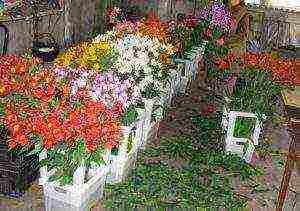
Growing an indoor garden requires a lot of effort and time to organize the care of green pets. But besides this, the florist must be well versed in flowering beauties and their varieties. After all, there are representatives of the flora who are undeservedly bypassed. We are talking about the flowers of home Alstroemeria, which belongs to the Alstroemeria family.
"Alstroemeria" in the language of flowers means "cute", "adorable", "desire to make a compliment." A bouquet of this type of flowers, as a rule, is presented to those girls who are in constant motion.
The name of the flower was given by Karl Linnaeus in honor of the Swedish botanist Claes Alströmer. The plant in wildlife can be found in South America and in the cold regions of the Andes mountains.
On one stem of the plant, you can find about 10-15 small-sized flowers. Their size is 5 centimeters in diameter. When looking at the flowers, one gets the impression that specks and dashes are drawn on them. Flowers have a varied shade: yellow, orange, pink, red, crimson, white, burgundy, purple.
The leaves on the flower are narrow, medium-sized, green. The flower reaches a height of one and a half meters. This plant starts up color for almost the entire summer period, starting from mid-June. Often it is grown specifically to be cut, since a bouquet of them can stand for a very long time - up to two weeks.
At home, alstroemeria is grown as an evergreen crop, the flowering of which depends on the time of sowing the seeds.
Growing at home and caring for
Alstroemeria prefers moderate temperatures.
In the summer, room temperature will be enough, but not more and not less than 20-22 degrees Celsius, and in winter - 13-15 degrees Celsius, the minimum - 8 degrees Celsius, despite the fact that the flower can withstand even slight frosts. But they are all equally intolerant of the heat.
Please note that at temperatures above 28 degrees Celsius, the plant freezes in growth, quickly sheds flowers, and withers. Too high air temperature in winter is an obstacle to buds on the flower, so the plant will not be able to start blooming.
Growing home alstroemeria requires regular spraying of air and protection from dry air from heating appliances on its buds. Under the influence of dry air, the discharge of all foliage and the collected color can occur.
The flower is light-loving, and in no way can it be attributed to plants that tolerate shaded places, however, if in autumn and winter it can be put on a window located on the south side, then in spring and summer shading is required in the daytime. Home care for the alstroemeria plant includes regular watering and fertilization with a predominance of potassium and phosphorus. With a high percentage of nitrogen, excessive growth of green mass and the absence of buds can be observed.
In order for the plant to bloom well, the length of the day should be at least 14 hours, therefore, fluorescent lamps are used for the flower.
In the spring and summer, it is recommended to water regularly, but not abundantly. The soil should have time to dry out before the next watering. In winter, watering should be limited.
The flower does not tolerate water stagnation in the roots, excess moisture, but dry soil will not lead to anything good. During the growing season, it is advisable to water the plant in such a way that the earth is a little damp all the time.
By the way, water for irrigation should be soft, chlorine-free.
Homemade alstroemeria flowers are advised to be fertilized, but it is necessary to monitor the nitrogen content, there should not be a lot of it. Transplanting… for her, it is recommended to transplant the flower every year in the spring. In this case, the soil should consist of leafy earth, peat, humus, perlite and pine bark in a ratio of 2: 1: 1: 1: 1. The acidity of the soil should be low. Drainage is required.
From seed in a pot
The alstroemeria flower propagates by seeds or by dividing the rhizome. Seeds should be sown in the month of February. And in May, you can transplant them into open ground.
The soil should be peat-rich.
It is recommended to stratify the seeds at a temperature of 2 to 4 degrees Celsius for one or two months, later the temperature should be increased to 20-25 degrees Celsius.
Growing alstroemeria from seeds in a seedling way allows you to get planting material for decorating the garden and windowsill. Such plantings look great on balconies and loggias.
This type of plant prefers heat and moisture, therefore, before starting to germinate seeds, it is imperative to soak them in water for at least 5-6 hours.
After that, it is recommended to plant them in a plastic container or in a wooden tray, which should be pre-filled with a mixture of river sand and leafy soil.
Moreover, a separate hole is formed for each seed, and the distance between them should be at least three centimeters. After you have planted the seeds, sprinkle them with substrate and water them well. Tighten the container later with plastic wrap. You can remove the film no more than once a day for a couple of minutes.
The place where the seedling trays are located should be warm and lighted. Under the film, the air temperature should be 22 degrees Celsius, otherwise the seeds will not sprout. If all the above conditions are met, the seeds will give seedlings in a week or 10 days.
After about two weeks, when you notice 3-4 leaves on young plants, they should be hardened, gradually increasing their residence time without a protective film.
However, this option for germinating seeds is suitable in cases where you want to leave the seedlings at home. Alstroemeria flowers in a pot will delight you with a lush bush and abundant flowering, if you choose the right container.
For 1 bush, a large pot with a volume of at least 5 liters is required.
For flowers that you then plan to transfer to open ground, it is advisable to carry out a stratification procedure, that is, germination at a temperature of no higher than five degrees Celsius.
Of course, in such a case, no more than half of the seeds will sprout, and this will take not a week or 10 days, but 2-3 weeks.
Nevertheless, the resulting seedlings will be more resistant to temperature extremes and even be able to safely survive spring frosts.
Remember to weed during the growing season. In the autumn, when frosts come, the upper part of the plant is cut off, and the roots are dug up. It is recommended to dry the earth lump so that the roots do not rot during storage. You can store it in a cellar or basement at positive winter temperatures.
Remember, when you work with a flower, it is better to use gloves, as the juice of its leaves can irritate the skin.
When alstroemeria begins to bloom, it is advisable to place it in a pot that is large in volume and size. At the same time, it is recommended to place the pot near the window.
Peruvian lily
The perennial tropical plant Alstroemeria is very often called the Peruvian lily because of the characteristic shape of the flowers, which are amazingly beautiful and have an exquisite aroma.
There are several dozen types of alstroemeria, the heart of which is South America, but almost all of them are suitable for growing in greenhouses or at home.
However, flower growers were still able to find an approach to thermophilic alstroemeria, which, if desired, can be used to decorate a personal plot. True, one should be prepared for the fact that if in winter the temperature drops below zero, the bulbs of the plant will die.
How to get seedlings
Alstroemeria seeds are not difficult to find today, since this luxurious flower is very popular among flora lovers. However, it should be borne in mind that the buds of young plants are formed only after two years.
Therefore, you should not count on the fact that, having received seedlings in spring, in the summer you will enjoy the flowering of this tropical beauty.
Nevertheless, if you decide to germinate alstroemeria seeds, then this should be done around the end of February, in order to plant flowers in open ground in May.
This plant loves moisture and warmth, so before germination, the seeds must be soaked in water for at least 5-6 hours. Then it is recommended to plant them in a plastic container or a wooden tray filled with a mixture of river sand and sheet soil.
Moreover, for each seed in this case, a separate hole is formed, and the distance between them should be at least 3 cm. After planting, the seeds are lightly sprinkled with a substrate and watered abundantly.
After that, the container should be tightened with plastic wrap, which can be removed to provide oxygen access once a day for several minutes.
The room in which the seedling trays are located should be very warm and light. At the same time, under the film, the air temperature cannot be lower than +22 degrees, otherwise the seeds simply will not germinate. However, the germination rate of alstroemeria is quite good, and after 7-10 days the seeds give seedlings.
After about 2 weeks, when young plants will have 3-4 leaves. Alstroemeria begins to harden, gradually increasing its residence time without a protective film. However, this option for germinating seeds is acceptable if you plan to leave the seedlings at home.
For plants that will subsequently be transferred to open ground, it is best to perform a stratification procedure, i.e. germination at a deliberately low temperature, which should not be higher than +5 degrees. Of course, in this case, no more than half of the seeds will sprout, and this will take not 7-10 days, but 2.5-3 weeks.
Nevertheless, the resulting seedlings will be more resistant to temperature extremes and even be able to safely survive spring frosts.
At home
These plants feel great in an ordinary flowerpot, so if you grow alstroemeria not for the street, but for the home, after performing the pick, each bush of seedlings should be placed in a separate container.
Alstroemeria develops quite intensively, therefore, you should immediately select a sufficiently voluminous flowerpot with a deep bottom, which must be covered with pebbles or expanded clay by a quarter.
As a substrate for alstroemeria, it is best to use a mixture of leaf and sod soil, which is recommended to be enriched with mineral fertilizers several times a year.During the flowering period, the plant is recommended to be watered with an aqueous solution of ash (1 tablespoon per 3 liters) at least 2-3 times a month.
In addition, it should be borne in mind that alstroemeria is very sensitive to various diseases, therefore, it is recommended to treat the plant with an aqueous solution of foundationol several times a year.
In the open field
It is recommended to transfer seedlings to open ground in mid-May, choosing bright and sunny places for alstroemeria. In this case, the seedlings are sown at a distance of 20-25 cm from each other, so that they have enough space to form a powerful root system.
Before planting alstroemeria for about a week, it is recommended to add a little ash to the soil, which will allow the flowers to adapt quite easily to new conditions.
Usually, alstroemeria begin to bloom only in the third year, and even then, subject to proper care. However, it is strictly forbidden to leave plants in the garden for the winter. Therefore, around the middle of October, alstroemeria are pruned and then dug up.
Flower tubers are stored in a cool and dark place, for which a cellar or basement is ideal. In this case, the bulbs themselves must be dry, otherwise the plant may die in winter.
In the spring, the tubers are again planted on the garden plot, fed with mineral fertilizers and watered abundantly throughout the season.
Overseas flowers
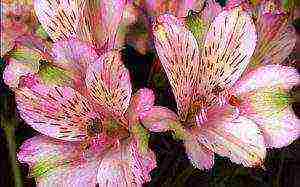
Alstroemeria (sometimes found - Alstroemeria) - flowers are incredibly beautiful, and therefore popular.
A bouquet made of alstroemeria, and even in combination with a popovnik (large chamomile) and fern stalks, looks luxurious and refined, and its price (which is important) is not at all burdensome for the budget.
After all, if outlandish and luxurious flowers need to be imported "from overseas", then growing alstroemeria on your own flower garden will not be difficult for anyone, even an inexperienced florist.
Growing and care
Alstroemeria is very similar in appearance to lilies and daylilies. Although they are often confused, they are different flowers. But according to the cultivation technology, this flower is very similar to the daylily. It can also be grown (propagated) both by seeds and by dividing the mother bush.
Of course, the second method is much simpler, not to mention the fact that the flowering of alstroemeria planted in this way will bloom much earlier. But, alas, it is not always possible to buy a piece of exactly the kind and color that you want. In this case, you will have to grow it yourself.
It is not difficult to grow alstroemeria from seeds. Something like this is grown, more familiar to flower growers, aster. That is, you can apply both seedling and non-seedling methods, directly into the open ground. But growing alstroemeria seedlings is still more efficient and reliable.
It is best to sow seeds for seedlings in late winter - early spring. The process of growing it is very simple and is no different from growing seedlings of most flowers and vegetables.
It is planted on the flower garden at the same time as tomatoes and peppers, that is, when the weather is stable. In most cases, this period occurs in late May - early June.
Over time, when the alstroemeria bush has reached a decent size, it is already possible to take cuttings from it for further reproduction. It is preferable to divide alstroemeria bushes after the flowering of the plant, in summer. But along with the summer division of the bushes, the spring division is practiced - with the beginning of the growing season, and the autumn - after the second flowering.
Note! There is no need to strive to get a lot from the bush. Especially if the bush is not very large yet. It is better to divide it into two or three parts, but so that each has strong, developed roots. Such delenki will take root faster and bloom earlier.
Landing
When choosing a planting site, be sure to be guided by the fact that alstroemeria needs a lot of light and good, light soil to bloom.
On heavy soils, it is unlikely that it will be possible to get a lush flowering. But there is nothing wrong. This soil can be lightened by adding a ripper.
As a ripper, you can use what is at hand: peat, compost, manure (rotted) and the like.
Keep in mind! Although good lighting for alstroemeria is one of the keys to successful cultivation, overheating of the soil can negatively affect flowering.
At soil temperatures above +23 degrees, alstroemeria begins to intensively grow the root system. This can be useful if you want to quickly get a shrub suitable for further division.
But you can not wait for flowering. Mulching will help protect the earth from overheating.
Watering
Waterlogging is unacceptable! This is one of the reasons why heavy soil is unsuitable for alstroemeria. From an excess of moisture, the roots of the flower rot, which will inevitably lead to its death. Therefore, if the summer is not dry, then you can do without watering at all. Mulch will help to retain the necessary moisture.
Top dressing
Without regular and high-quality fertilizing, it is unlikely that it will be possible to get a luxurious flowering of alstroemeria. And it is necessary to apply fertilizers often. At least three times a month. For top dressing, you can use both mineral and organic fertilizers.
From the beginning of the growing season to the setting of buds, potash fertilizers with a high nitrogen content are preferred. With the appearance of buds and during the flowering period, the nitrogen content in the fertilizer decreases, but the percentage of phosphorus increases.
Any of these fertilizers can be purchased easily, but you can also make yourself from very well-rotted mullein or bird droppings. It is advisable to add wood ash or ash.
Wintering
In order to protect the flower from winter frosts, after pruning the shoots (up to about ten centimeters in height), it is enough to cover it with any available material: fallen leaves, peat, sawdust, etc.
If the winters in your area are very frosty, and especially if the alstroemeria bushes are still very young, then you can do the same with chrysanthemums - dig them up and store them in the cellar until the next season. But in most cases, alstroemeria tolerates wintering well without such drastic measures.
This especially applies to zones with a temperate climate, not to mention the southern regions, where it can do without any shelters.
In the cut
In addition to exquisite beauty, bouquets made of alstroemeria are highly durable. Such a bouquet can delight you for a very long time. He is able to maintain its freshness for up to a month or more.
But if you buy a bouquet, then give preference to one with the maximum number of unopened, but already colored buds. Be guided by the same when cutting flowers in your flower garden. Unopened buds will open perfectly in a vase of water.
Before placing flowers in a vase, the lower third of the stem must be cleaned of leaves.
Alstroemeria is a blooming decorative culture, which nowadays can often be found in almost every more or less large flower shop. Moreover, these flowers can be seen in stores much more often than in flower beds, backyards or garden plots. This is a very fashionable culture today, whose flowers look great in absolutely any bouquet and are harmoniously combined with most other popular flowers.
According to professional florists, it is most wonderful in cut form combined with a nivyanik. Many of our contemporaries often mistakenly believe and confuse this flower with a lily or daylilies. Nevertheless, in fact, alstroemeria have absolutely nothing to do with these cultures.
Growing and breeding methods
Literally recently, the cultivation of alstroemeria has become popular on the territory of our country, at home and in the open field.Moreover, if you competently study the recommendations of experienced flower growers, then planting and caring for these very beautifully flowering plants will be quite simple and even a novice gardener can do.
The shrub can be propagated in two ways:
- by dividing the bush;
- using seeds.
Naturally, acquiring a ready-made adult plant and propagating it by dividing it is a much simpler event than growing from seeds. Moreover: if such a plant is grown with the help of seeds, then its flowering will not come soon - approximately after 2-3 years from the moment when the planting was carried out, and even provided that the care was carried out correctly. At the same time, it is far from always possible to acquire a bush (that is, a delenka) of exactly the kind that you want.
In this case, you will have to master the process of growing from seeds. It also cannot be called particularly difficult - in any case, it is not much more difficult than growing asters at home.
In general, it is possible to do this in two ways:
- Sowing seeds directly into open ground.
- Initially, grow seedlings from seeds, and only then transplant the shoots into the soil.
When there is a desire to get the highest quality result, experts recommend using the second method, that is, to deal with seedlings. Sowing seeds for seedlings should be done in February. There are no peculiarities of growing seedlings - all the same rules are characteristic for this process as for growing seedlings that are popular today. Planting seedlings of this shrub in open ground should be carried out at the end of May, when the air temperature will already be constant, that is, it is always warm outside. Caring for seedlings planted in the ground does not require much effort. But, of course, you should definitely familiarize yourself with the recommendations of experienced flower growers, study all the features that competent care for immature sprouts that have just been transplanted into the ground has competently.
In the event that you managed to grow or buy an adult bush of a large enough size, it should be divided. Florists recommend doing this kind of procedure in the summer at the end of the flowering period of this plant. Nevertheless, many experts argue that it is possible to divide alstroemeria, not only in the summer months, but also in the fall at the end of flowering, as well as in the spring season - when the growing season is at the very beginning. The division procedure must be carried out extremely carefully! In the event that the bush is not very large, you should not try to divide it into a large number of parts. It is optimal to divide the shrub into 2, maximum 3 parts. In this case, the roots of each part must be strong and well developed - otherwise, you will have to wait a very long time for the onset of the flowering period.
Planting procedure: process features
Choosing the right place where such a plant will be planted is an extremely important point in growing alstroemeria. It is on this that the quality of the flowering of the plant directly depends, in many respects. The planting site should be well lit, have good, light soil. Feels bad on heavy soil. When there is no special choice in terms of area, it is necessary to lighten the ground - for this purpose, a ripper must be added to the soil. Experienced flower growers recommend the use of rotted manure, sheet compost, and high-moor peat as a ripper.
According to experts, lighting in this case is also of great importance. Nevertheless, one feature should be taken into account: in conditions of high soil temperatures (23 degrees Celsius and more), intensive development of the roots of the bush begins to occur, the formation of large tubers, which, from a certain point of view, is not bad. But such a situation will lead to damage in terms of flowering. On overheated soil, it may not bloom at all.Solving this problem is relatively simple - you should protect the ground around the root system of the bush with mulch - in addition to protecting against overheating, it will also help to additionally retain moisture in the soil.
There is also such a feature: if you want alstroemeria to bloom in the spring-summer period, then the planting of a delenka bush should be carried out in the autumn season (from the beginning of September to the end of October).
Care: basic rules
The process of watering during cultivation must be treated very carefully and carefully, be sure to follow all the rules and advice of experienced florists! It should be remembered that the flower does not accept when the soil is waterlogged - this situation is fraught with rapid decay of the root and complete death of the bush in the near future. At the same time, it is not only proper watering and care that is important.
Root decay is especially possible when the owner of a backyard or summer cottage, who is growing alstroemeria at home, ignores the requirements and recommendations of experts regarding the looseness of the soil! It must be remembered that the risk of root rot in a plant growing on heavy soil is much higher. It is imperative to maintain optimal soil moisture - this can be done not only with mulch, but also with wood sawdust, peat, leaf compost, etc.
Top dressing when growing alstroemeria is a mandatory procedure. At the same time, this plant should be fed at least 3 times during one month, and even better 4 times / month. Until the buds appear, feeding should be carried out using a complete mineral fertilizer, which contains an increased potassium content.
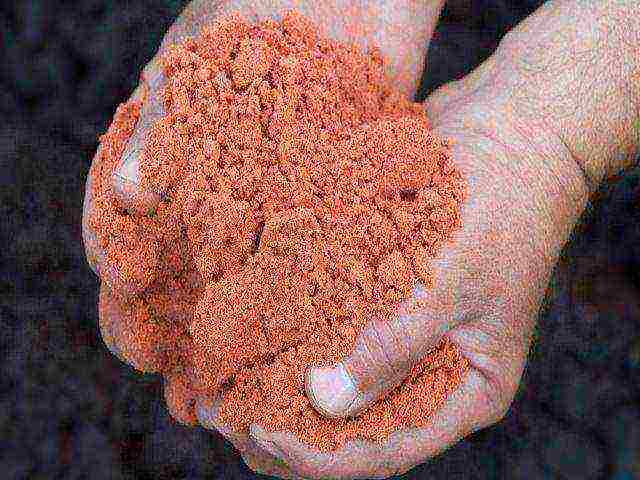
After the buds have appeared and until the moment when the flowering period of the shrub is completely over, the use of this fertilizer is absolutely appropriate. But there is one important rule: you should definitely pay attention to the fact that nitrogen in the composition of the mineral fertilizer that is used is contained in the minimum amount. Everyone will agree that at the present time, almost every traditional specialty store or on the sites selling fertilizers intended for the cultivation of all kinds of decorative flowering crops, an extremely wide range of these products is offered. Therefore, choosing the most suitable for growing such a flowering plant as alstroemeria is not a problem.
In addition, it is allowed to feed this plant with the help of organic matter. But there are some recommendations in terms of the use of mullein, and especially poultry droppings - you can use only those organic fertilizers that are enough overfilled when growing at home! Moreover, when feeding, they should be used only in small quantities.
Wintering recommendations
As a rule, an adult plant of such a plan as alstroemeria tolerates winter conditions well in temperate latitudes. Nevertheless, experts in cultivation advise to be on the safe side just in case, because it does not require much effort. In the case when the shrub is young, it is recommended to dig it up (just like digging up chrysanthemums or dahlias). If the bush is already mature and well developed, then preparation for wintering can be greatly simplified: create additional shelter with the help of spruce branches, leaves, sawdust, and more. etc. Before that, you should cut off the shoots, leaving approximately about 8 centimeters above the soil surface. That's all the care for such a plant in the winter.
Cutting rules and storage features for cut flowers
According to most growers, the cutting process is simple. The main rule is one: it is necessary to cut off alstroemeria inflorescences with a very sharp knife and always at a slight slope.After that, it is required to place the cut buds in water as soon as possible, where they will fully open.
But before you put the cut plants in the water, it is imperative to remove absolutely all the lower foliage, which is available on 1/3 of their stems. Naturally, cut plants also need competent care - you should update the cut from time to time and change the water in the vase.
Was this helpful?
Rate the article:
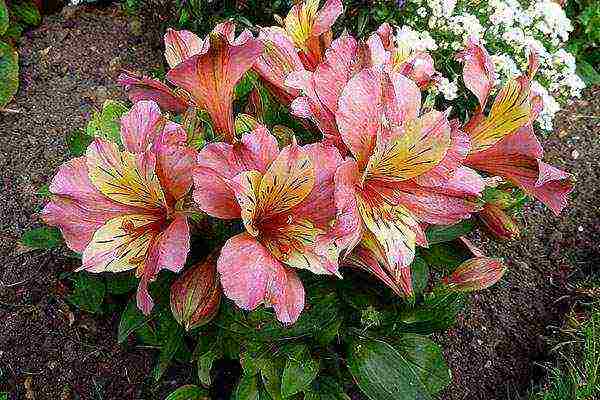 Alstroemeria are flowers that, due to their external resemblance, are called the Peruvian lily or the Inca lily. It is a perennial herb that is distinguished by its bright flowering and unusual color of the leaves. Alstroemeria is added to bouquets and is most often grown in greenhouses in large quantities. This plant requires special conditions of care and maintenance, but if desired, it can be grown at home.
Alstroemeria are flowers that, due to their external resemblance, are called the Peruvian lily or the Inca lily. It is a perennial herb that is distinguished by its bright flowering and unusual color of the leaves. Alstroemeria is added to bouquets and is most often grown in greenhouses in large quantities. This plant requires special conditions of care and maintenance, but if desired, it can be grown at home.
Description and types of plants
Before you grow this flower at home, you should familiarize yourself with the description and photo of alstroemeria, choose a suitable variety. These are tall plants that can grow up to 80-150 cm or more. All varieties differ in petal color, but have a characteristic leaf shape. Individual leaves turn around their axis during growth and can be directed upward with the bottom plate.
Among the most popular varieties of alstroemeria flowers are:
- Golden alstroemeria is a bright yellow flower that naturally grows in Peru. This variety is considered high and can reach 150 cm. Its main feature is that it can withstand frosts down to -13 ᴼС.
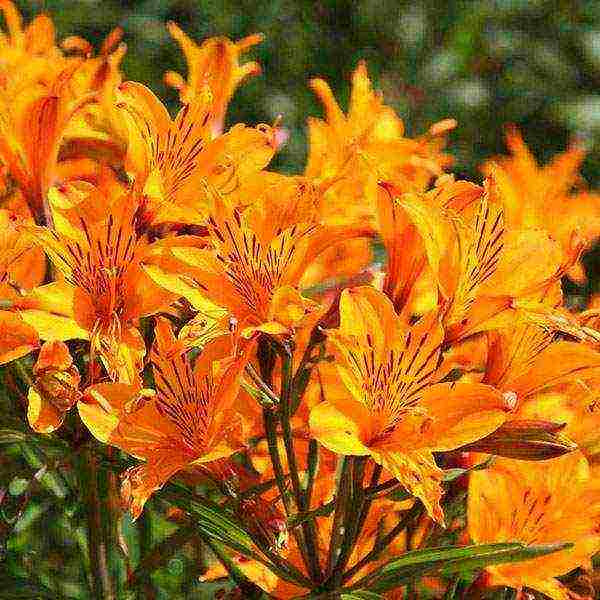
- Alstroemeria Brazilian is a tall flower that can grow up to 2 m. The petals of flowers are painted in a bronze or red hue.
- Alstroemeria nano is a Peruvian variety. It is a small plant that grows up to 10 cm. Flowers of this species of alstroemeria are colored yellow with dark spots.
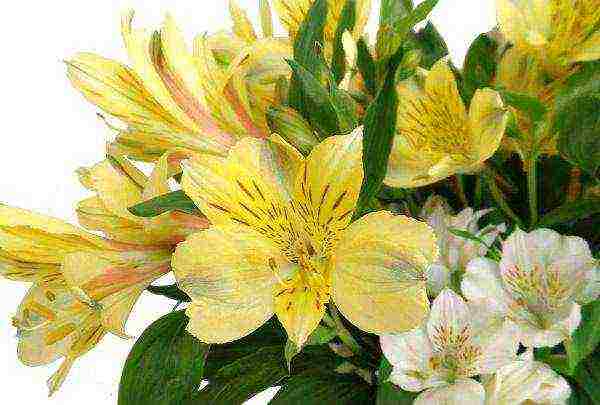
- Blood-flowered alstroemeria is a variety that naturally grows in Chile and Peru. It is appreciated for the fact that up to 15 large bright flowers can appear on one plant. All of them are colored intense red.
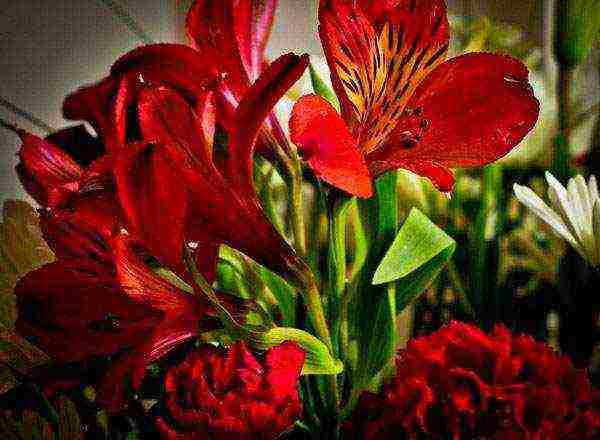
There are other varieties, many of which have been artificially bred by breeders. For example, the Cosmo variety is distinguished by the snow-white color of the petals. Virginia is another variety with white flowers, but the edges of their petals are wavy.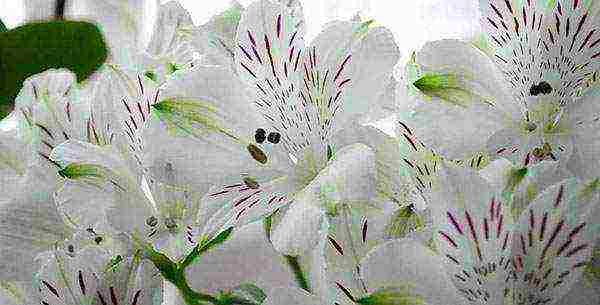 The varieties Beauty (with lilac or purple flowers), Harmony (bronze flowers with black stripes) and Canaria (flowers with a canary hue and black blotches) can bloom twice per season.
The varieties Beauty (with lilac or purple flowers), Harmony (bronze flowers with black stripes) and Canaria (flowers with a canary hue and black blotches) can bloom twice per season.
To grow alstroemeria in the garden, you should choose only those varieties that tolerate frost.
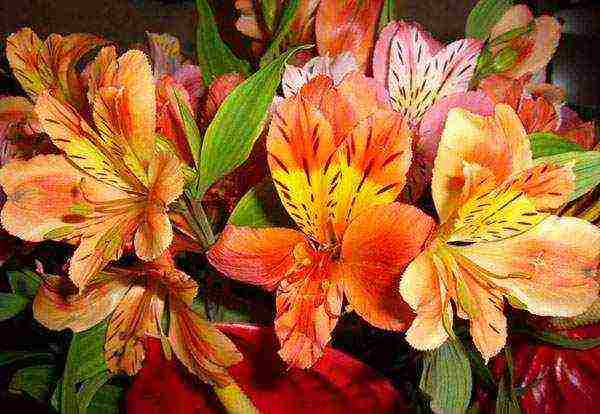
Features of growing at home
Alstroemeria is an exotic plant, so it will need to create the most comfortable conditions. It can be grown in the garden, in the greenhouse, or in pots on windowsills. With proper planting and care, alstroemeria will delight with large flowers and become a bright decoration of the garden.
Alstroemeria breeding methods
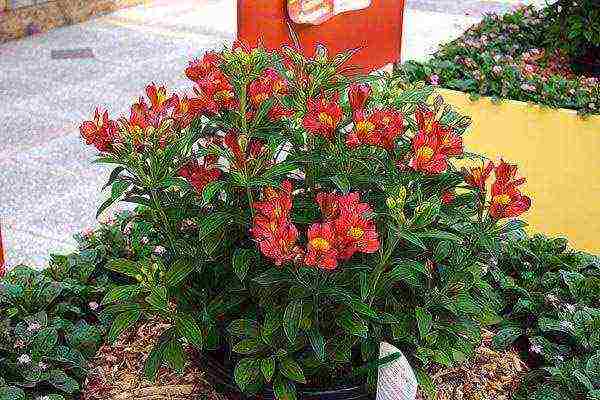 The plant can reproduce in two main ways: by seed and by dividing the rhizome. The first method is suitable only for species varieties, since hybrids can lose the properties of mother plants. You can collect seeds from those flowers that are already growing on the site, but you need to take into account that the fruits are very fragile. At the slightest touch, their peel cracks, and the seeds fly in all directions from the flower. Before collecting seeds, the plant should be covered with gauze. Further, the seeds must go through several stages:
The plant can reproduce in two main ways: by seed and by dividing the rhizome. The first method is suitable only for species varieties, since hybrids can lose the properties of mother plants. You can collect seeds from those flowers that are already growing on the site, but you need to take into account that the fruits are very fragile. At the slightest touch, their peel cracks, and the seeds fly in all directions from the flower. Before collecting seeds, the plant should be covered with gauze. Further, the seeds must go through several stages:
- stratification - seeds are sent to the refrigerator for 2-3 months;
- in late winter and early spring, seeds can be germinated;
- at the end of stratification, they are placed in small containers in the ground to a depth of 1 cm.
Seeds germinate at 18 ° C.They will make seedlings, which can then be transplanted into open ground. When growing alstroemeria flowers from seeds, they will be able to bloom only in the third year after planting.
The second method is the reproduction of alstroemeria by dividing the rhizome. It is also suitable for hybrids, since the new plants retain all the properties of the mother. You need to divide the rhizome in the fall, at the end of the flowering period. The plant is carefully dug out, trying not to damage the roots, and then divide them into 2-3 parts. Each of them must have a fully formed root system. The sections are treated with disinfectants, and the bushes are placed back into the ground.
Outdoor cultivation
 Planting alstroemeria in open ground and caring for it takes time and attention. The plant needs to create the most comfortable conditions in which it can grow and reproduce:
Planting alstroemeria in open ground and caring for it takes time and attention. The plant needs to create the most comfortable conditions in which it can grow and reproduce:
- watering frequency - 1 time per week, in drought conditions, you can water 2 times in 7 days;
- after each watering, the soil is loosened;
- fertilizers - compost during planting, then organic or mineral fertilizing three times a month;
- before the start of the cold season, the green part of the plant is cut off, and the rhizome is covered with leaves, peat or covering material.
If no further collection of seeds is planned, it is recommended to cut the buds at the end of flowering. So in their place, new flowers are formed faster.
Growing in a greenhouse
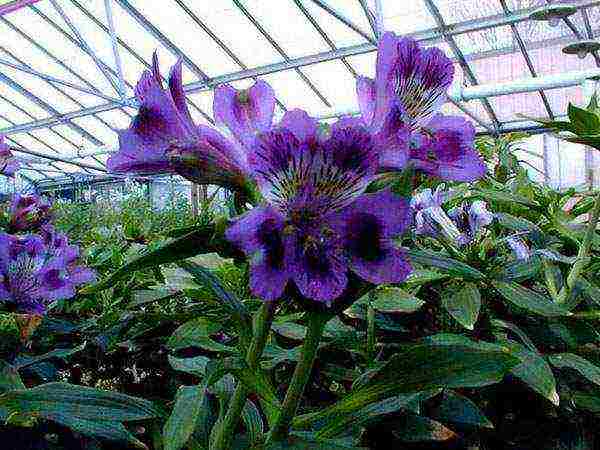 It is convenient to grow alstroemeria in a greenhouse on an industrial scale. Here you can create the most comfortable climate even in the absence of suitable weather conditions. The soil should be composed of sand, leaves, peat and humus. It needs to be watered constantly, but moisture should not be stagnant. Top dressing is applied twice a month; for this, nitrogen-potassium fertilizers are used.
It is convenient to grow alstroemeria in a greenhouse on an industrial scale. Here you can create the most comfortable climate even in the absence of suitable weather conditions. The soil should be composed of sand, leaves, peat and humus. It needs to be watered constantly, but moisture should not be stagnant. Top dressing is applied twice a month; for this, nitrogen-potassium fertilizers are used.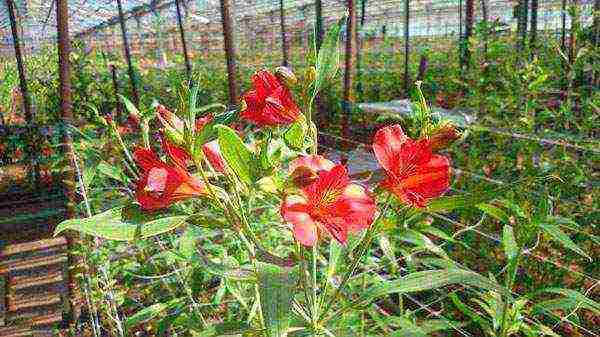 In winter, alstroemeria also blooms in the greenhouse, but it will need additional lighting. The temperature regime is about 15 degrees during the daytime, and 13 at night. During intensive flowering, it is increased to 18-20 degrees.
In winter, alstroemeria also blooms in the greenhouse, but it will need additional lighting. The temperature regime is about 15 degrees during the daytime, and 13 at night. During intensive flowering, it is increased to 18-20 degrees.
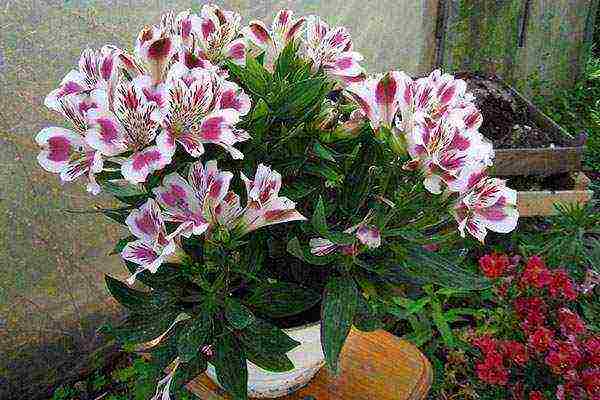 Alstroemeria can also grow in pots at home. It is imperative to make a hole in the center of the container in order to prevent moisture stagnation. It is not necessary to feed and fertilize the plant. Watering it is enough once every 3 days, and the pot is placed in the lightest place.
Alstroemeria can also grow in pots at home. It is imperative to make a hole in the center of the container in order to prevent moisture stagnation. It is not necessary to feed and fertilize the plant. Watering it is enough once every 3 days, and the pot is placed in the lightest place.
Alstroemeria is a large number of very different varieties that differ from each other in size, color and shape. This is an exotic flower, but it is possible to grow it in an average climate. Most often, it is planted in greenhouses, which allows you to regulate the illumination and temperature. Large, bright flowers can be difficult to produce outdoors due to fluctuations in soil temperature and moisture. At home in a pot, alstroemeria will feel comfortable, but the ray will choose low varieties.
Growing alstroemeria in pots - video


